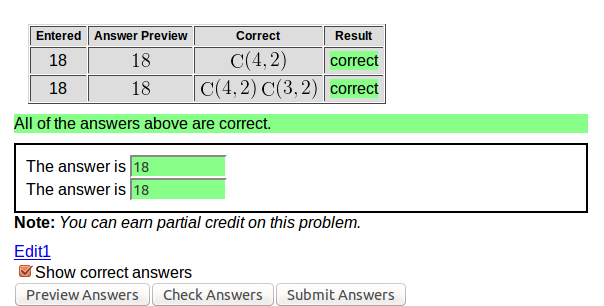The problem is that
$a is actually just the real number 6 (equivalent to
Real(6)), not a Formula object, but with its
correct_ans field set to the string
C(4,2) (and its
correct_ans_latex_string set to the appropriate thing). When you do
$a*$b, you end up with the equivalent of
Real(18), again just a Real MathObject. The Real inherits properties from the first factor (
$a), but some properties where supposed to be removed, including the
correct_ans, since it no longer applies. The
correct_ans did get removed, but the
correct_ans_latex_string did not (this value was added rather recently, so hasn't had a lot of testing), which is why it shows up a
C(4,2) in the correct answer rather than 18 as it should have. I will need to fix that bug.
One way to handle this is the following:
Context()->flags->set(reduceConstantFunctions=>0,reduceConstants=>0);
$a = Formula("C(4,2)");
$b = Formula("C(3,2)");
BEGIN_PGML
The answer is [______________]{$a*$b}
END_PGML
This works, but the type of answer will be a Formula, so you will get error messages that say you are looking for a Formula, and it will
not give error messages if you include x in your answer.
If you really want to get it right, you need to do something like
Context()->flags->set(reduceConstantFunctions=>0,reduceConstants=>0);
$a = Formula("C(4,2)");
$b = Formula("C(3,2)");
$d = $a*$b;
$d = $d->eval()->with(
correct_ans => $d->string,
correct_ans_latex_string=> $d->TeX
);
BEGIN_PGML
The answer is [______________]{$d}
END_PGML
This will produce the proper error messages (since
$d is a Real), while showing the proper correct answer (since the
correct_ans is set explicitly). A bit unpleasant, but it works.
